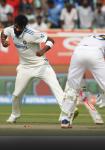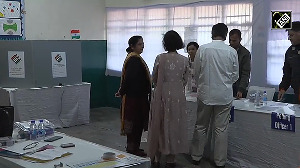Commodity products like salt, milk and water have made their mark as brands. But sugar has not yet been able to make the transition successfully.
Why have branding strategies in the category not yet taken off and what are the steps taken by sugar manufacturers to reverse the position?
Sugar as an overall category is worth a cool Rs 25,000 crore (Rs 250 billion). In comparison, toilet soaps, which is the largest category in the branded fast moving consumer goods segment, is about Rs 5,000 crore (Rs 50 billion).
And just FMCG major Hindustan Lever's key toilet soap brands such as Lifebuoy, Lux, or Breeze are individually estimated to account for more than Rs 500 crore (Rs 5 billion) in revenues.
But despite the fact that many sugar companies have stirred the branding game, there are no major branded sugar daddies worth writing home about.
What gives? Why has sugar not been able to successfully transition from a commodity to a branded product? One answer is that sugar is a low involvement category, despite the fact that most customers cannot do without spiking their morning cuppa with sugar. Even those who opt for brands have little or no brand preference.
Consider a typical consumer response: "Branded sugar is cleaner. But I always opt for the cheapest branded sugar available," says Tina Chawla, a shopper in Delhi. Her logic: sugar by any name tastes as sweet.
Hardly surprising, then, that many sugar manufacturers have even given up the branding efforts, while other major players are yet to take the plunge.
For instance, Balrampur Chini, which commands a 8.69 per cent market share in the commodity sugar space (Source: Karvy Commodities), opted out of the brand game. Despite spending Rs 2 crore (Rs 20 million) on launching its brand in 2002, the product failed to contribute even 1 per cent to the company's turnover.
"People still see sugar as a commodity," comments Kishor Shah, director and CFO, Balrampur Chini Mills.
Further, there are large sugar players in the country who, while having taken giant strides in the commodity market, have not even entered the brand stand. One example is market leader, Bajaj Hindusthan, which commands a market share of 12.67 per cent in the overall Indian sugar industry.
As for those who continue to be present in the branded market, such as Shagun, a sugar brand from Triveni Engineering and Industries, or Dhampur Sugar's brand, Dhampure, Modi Sugar's, Originale, or Simbhaoli Sugar's, Trust, they are far away from becoming household names.
"Since many commodity players were prospering in the FMCG segment, we initially thought about entering the market as well," says R Banka, chief general manager, corporate affairs, Dwarikesh Sugar Industries.
On ground, buyers still do not see compelling reasons to buy branded sugar. However, there are strong reasons to go in for branded atta, or salt for that matter.
"Unlike sugar, all other branded commodities have distinctive value-adds that justify the premium prices," says a Delhi-based commodities expert. For instance, branded atta ensures a consistent quality of flour every month and ends the tedious process of selecting wheat from stores and visiting the local flour mill to grind it.
For salt, iodine is the value-add that scores, while in the case of basmati rice, the distinctive aroma justifies the premium.
Another analyst adds, "That explains why big FMCG companies such as HLL and ITC are into several commodities but have chosen to stay away from sugar." When contacted, ITC executives said they had not given the sugar category a serious thought.
But there is a silver lining in the cloudy skies. Production of sugar in India, at 19.5 million metric tonnes in 2005-06, is among the highest in the world.
Even consumption has remained consistent at 19-20 million metric tonnes per year since the last five years. Even if the top 5 per cent of Indian consumers convert to branded sugar, it's a Rs 1,200-crore (Rs 12 billion) business opportunity (since the sugar business in the country is worth Rs 25,000 crore).
That could catapult sugar into the big league in the branded foods category. Consultants Technopak Advisors estimates that branded atta is currently worth Rs 820 crore (Rs 8.2 billion), iodised salt is Rs 1,016 crore (Rs 10.16 billion) and packaged rice is a Rs 150-crore (Rs 1.5 billion) market in India.
In a shot, sugar could be ahead. And that is what some of the existing players in the branded sugar market are hoping to cash in on and are trying to make a strong push in a difficult market context. Just how are they doing it?
Will they succeed?
Tough choices
How do sugar brands add value? To be sure, there have been some attempts. Dhampur Sugar, for instance, claims to offer double-refined, sulphurless, regular white sugar.
But there is a problem: the price premium over the sugar that the neighbourhood grocer sells. A 1-kg pack of Dhampure costs Rs 30, while the kiraana store sells sugar at roughly Rs 20 a kg.
"Our consumers are willing to pay a few extra bucks to invest in a healthy lifestyle. We're trying convert a commodity into a lifestyle product by positioning it on the health platform," says Arhant Jain, group vice president, finance, Dhampur Sugar.
Other branded sugar players echo Jain's thoughts. Originale has launched a low calorie sugar variant called Half Spoon. True to its name, Half Spoon claims to give just half the calories of regular sugar. But at Rs 60 for 240 gm, Half Spoon is, to put it mildly, expensive.
But there is another issue that branded sugar players will have to contend with. Health and sugar are oxymorons as far as consumers are concerned. Consultants agree.
Says Munir Suri, vice-president, Technopak Advisors, "Sugar consumption is linked to bad health. So playing upon the health platform is very challenging for branded sugar."
Then, most supermarkets and retail outlets display branded sugar besides artificial sweeteners such as SugarFree, Equal and Zero. Artificial sweeteners are in the same price range as Half Spoon. So a health-conscious customer's choice could go either way.
Point of consumption
Another strategy has been to introduce the concept of branded sugar at points of consumption. The biggest opportunity is during the consumption of tea.
Modi Sugar Mills' brand Originale offers an innovation of "flavoured sugar" sachets aimed at tea lovers. The flavoured sugar ranges from ginger, ginger-lemon, tulsi, cardamom, earl grey and masala.
For Rs 36, consumers can buy 100 gm packs comprising 20 sachets of sugar. The bad news is that flavoured tea brands such as Tata Tea are available at lower price points. A pack of 12 sachets costs Rs 20. Then, retailers also sell flavoured tea sachets at Rs 2 per serving. Finally, flavoured tea is a niche category and so is flavoured sugar.
At another level, with iced tea consumption increasing, branded players are also focusing on sugar syrup. Dhampure's Flo costs Rs 45 for 500 gm or Solar Golden Syrup by Solar Sugar is priced at Rs 75 for 700 gm. Coffee bars, hotels or airlines are the next opportunities.
Further, branded sugar is pushed to coffee lovers in the form of brown sugar, sugar cubes, quick dissolve sugar, breakfast sugar and so on. Simbhaoli's Trust has tie-ups with hospitality chains like Taj Mahal and Oberoi's.
It has also tied-up with airlines like Air Sahara, Air-India and Indian Airlines. There are also tie-ups with chains such as Café Coffee Day and Nirula's amongst others.
But many retailers are not convinced. According to them, on-premise consumption of branded sugar at coffee bars or airlines is not the same as consumption at home.
"In a month, we sell only two-three packs of these sugar variants for home consumption. A pack of liquid sugar sells in about two months or so," reveals a Delhi-based retailer.
Need an occasion
Festivals or celebration of every kind are incomplete without the customary indulgence in sweets. Branded sugar manufacturers are ensuring that they are present where it matters.
For instance, Triveni's Shagun has also stepped out of stores to catch consumers during the wedding season and festivals. Shagun co-sponsored the large-scale Durga Puja celebrations at south Delhi's Bengali hub, Chittaranjan Park.
In November 2005, Shagun extended its presence from north India to West Bengal, a state known for its sweet tooth. It plans to use this year's festive season to increase visibility and brand awareness in the state.
"We intend to imbibe best practices from FMCG leaders in distribution, sales and marketing. So we're considering co-branding with other FMCG brands," says Tarun Sawhney, corporate vice-president, Triveni Engineering and Industries.
The company's already had tie-ups with popular tea brands. Customers buying tea get a Rs 7 discount on a pack of Shagun.
Even, Trust from Simbhaoli has tried its hand at promotions. Apart from a three-plus-one offer, it also gifted consumers buying two 500 gm packs of sugar cubes with a mug.
But as many promotions do, they might result in a temporary rise in sales. But, how do you sustain the excitement?
Says Ravi Gupta, president, sugar and alcohol, Bajaj Hindusthan, "Sugar branding requires a low-cost strategy. Only then, can you recover costs." That's the key piece left in the puzzle. Because, sugar manufacturers have played by the strategy rule book so far in the branding game.
From launching healthier options and innovative variants to putting the product in the right places with the promotions, they have tried a variety of strategies to gain larger spoonfuls of the market. A key issue that remains, is to crack the price-value equation. At that time, branded sugar may taste sweeter.
Quick bite - Unique Lesson
Ever wondered why popular food brands such as Annapoorna or Saffola, which are present in categories ranging from salt to atta, do not lend their name to sugar. One explanation is that there are various government policy reasons not to be there.
Sugar is a controlled commodity, government quotas dictate how much companies can sell every month, a certain percentage of inventory needs to be kept in government warehouses and most consumers buy sugar through the public distribution system. But despite all these, consultants say that sugar marketers can still make a mark. And how?
Rajeshwari Sheth, a senior Mumbai-based marketing professional says, "When customers are not interested in the basic commodity, fortification makes sense."
In other words, brands must have a strong enough selling proposition. Take the example of Captain Cook in wheat flour (atta) and salt.
In wheat flour, Captain Cook was projected as being made out of grains that were of a gold standard, while in salt, it differentiated itself on the "free-flow" superiority. Similarly, Catch, another brand of salt, differentiated itself on the basis of its packaging - it was packed in the form of a dispenser.
Classic marketing wisdom says that fortification or unique propositions give brands a definite hook. "To remember the brands, customers need a hook. When they have to choose a brand from the rack, they are more likely to remember brands that said something positive," says Sheth.
A Mumbai-based commodities expert adds, "The hope is that India's retail boom will boost all branded products, including sugar." And while choosing in a large-format retail store, customers looking at Kissan Annapoorna think fortified atta, right? Surely, sugar could pick up some cues.
With inputs from Prasad Sangameshwaran







 © 2025
© 2025